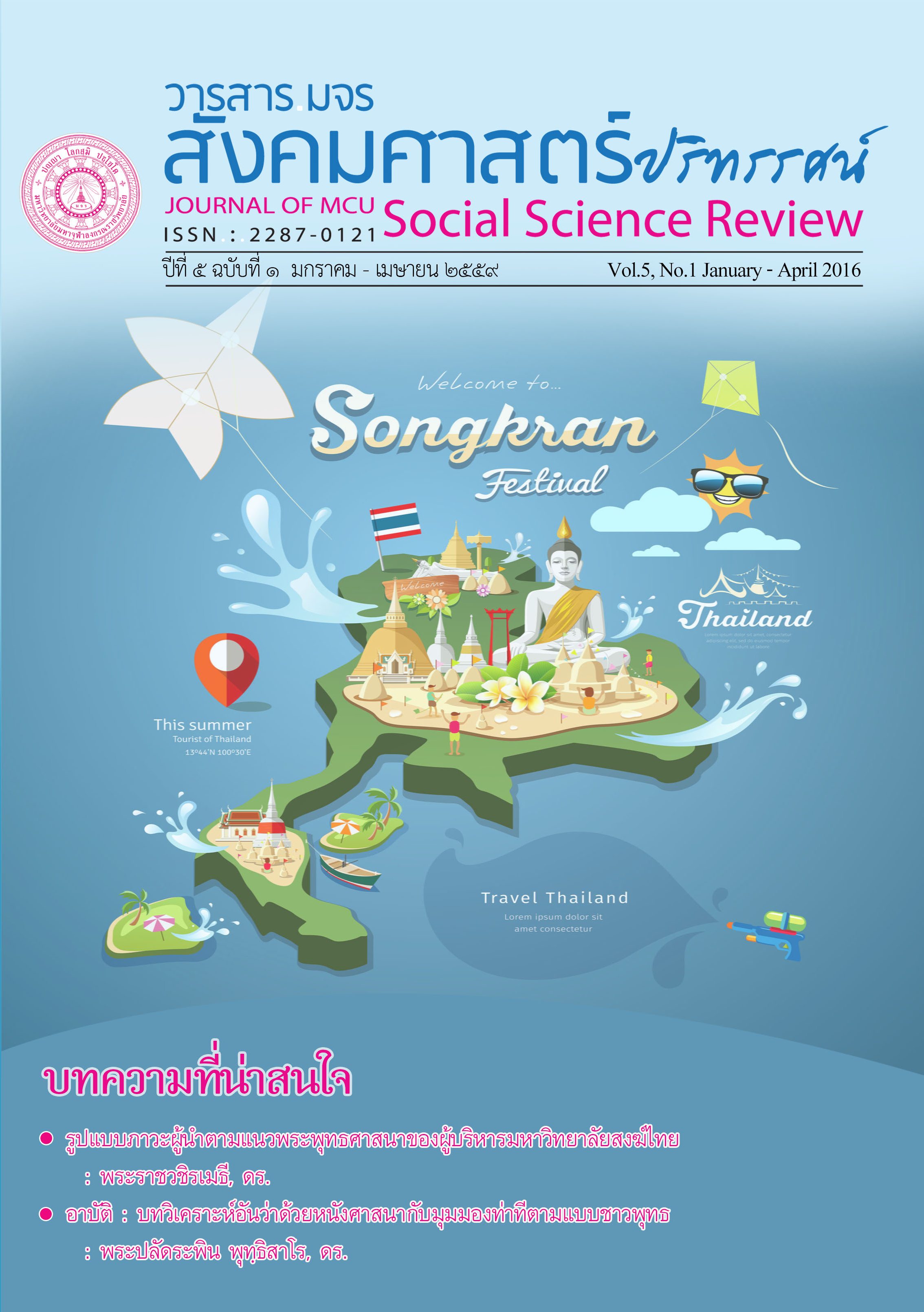รูปแบบการเผยแผ่พระพุทธศาสนาของพระธรรมทูตในจังหวัดอ่างทอง
คำสำคัญ:
การเผยแผ่, พระพุทธศาสนา, พระธรรมทูตบทคัดย่อ
บทความวิจัยฉบับนี้มีวัตถุประสงค์ คือ ๑) เพื่อศึษาแนวติด ทฤษฎีเกี่ยวกับการเผยแผ่พระพุทธศาสนาที่มีคุณภาพที่เหมาะสม ต่อการนำมาเป็นแนวทางการเผยแผ่พระพุทธศาสนาของพระธรรมทูตในจังหวัดงทอง ๒) เพื่อศึกษาและวิคราะห์ปัญหาทั่ไปที่ส่งผลต่อคุณภาพ การเผยแผ่พระพุทรศสนาของพะธรรมทูตในจังหวัตอ่างทอง ๓) เพื่อหารูปแบบและวิธีการเผยแผ่พระพุทธศาสนาที่มีคุณภาพ เพื่อนำมาเป็นแนวทางการเผแผ่ของพระธรรมทูตในจังหวัดอ่างทองดำเนการวิจ้โตยเป็นการจัยเชิงคุณภาพ ก็บข้อมูลจากผู้ให้ข้อมูลสำคัญด้วยการสัมภาษณ์เชิงลึก จำนวน ๒๕ รูป/ตน และการสนทนากลุ่มเฉพาะ จำนวน ๓ด รูป/คน เครื่ยงมือที่ใช้ในการวิจัยครั้งนี้ คือ การสัมภาษณ์ แสะการสนทนกลุ่มฉพาะ วิเคราะห์ข้อมูลโดยการพรรณนาความ และจัตหมวตหมู่เพื่อสรุปเนื้อหานำไปสู่การพรรณนา และสรุปผลการวิจัยตามวัตถุประสงค์ที่ตั้งไว้ผลการวิจัยพบว่า๑) แนวคิด ทฤษฎีเกี่ยวกัการเผยแผ่พระพุทธตาสนาที่มีคุณภาพที่เหมาะสม ต่อการนำมาเป็นแนวทางการเผยแผ่พระพุทธศาสนาของพระรรมทูตในจังหวัดถ่งทอง พบว่า การเผยแผ่พระพุทธศาสนานั้นได้ดำเนิการมาตั้งแต่ครั้งพุทธกาล ซึ่งรูปแบบในการเผยแผ่พระพุทธศาสนานั้นมีการหลายรูปแบ ยกตัวอย่างเช่น การปฏิบัติตนจนเป็นที่นเสื่อมใส การสำรวมระวังในการสนทนา การให้คำแนะนำแบบเป็นกลาง การตอบปัญหาข้อข้องใจที่ตรงประเด็น และการแสตงธรรมที่ชัตเจนเข้าใจง่ย ไปตามลำตับ โดยอาศัยพระบูรพาจารย์ผู้แตกถานในพระธรรมวินัยเป็นกำลังสำคัญ นอกจากนี้ การผแผ่พระพุทธศาสนาที่เหมาะสมต้องเผยแผ่ตามประเพณีคณะสงฆ์ และตามประเพณีไทย การเผยแผ่ต้องปรับปรุงให้เหมาะสมกับสภาพสังคมปัจจุบัน และปรับประยุกตัการเผยแผ่โดยจัตเป็นคณะหรือหน่วยงานเผยแผ่หรือเป็นสถานศึกษาเป็นที่ประจำหรือครั้งตราวหรือจัตเป็นกิกรมพิเศษภายในวัด หรือในหมู่บ้านไกล้เคียง๒) ปัญหาทั่วไปที่สผลต่อคุณภาพ การเผยแผ่พระพุทธศาสนาของพระธรรมทูตในจังหวัตอ่างทอง พบว่า มี ๔ ต้าน ดังนี้ (๑) ปัญหาด้านเนื้อหาหลักธรรม คือ พระธรรมทูตขาตความในเรื่องที่จะแสดงธรรม ขาดทักษะและเทศนิคในการแสดงธรรมที่ตี และพระธรรมทูตมีบทบาทจำกัดเพียงการอกบรรยายธรรมนอกวัดที่มีอยู่น้อย และปัญหาการมีทัศนะพื้นฐานต่อการเป็นทระธรมทูตและงานโดยบทบาทและหน้ที่ของพระธรรมทูตไม่ครอบตลุมครบต่อสังคมโดยรวมอย่างชัดเขเก่าที่ควร (๒) ปัญหาด้านกิกรรม คือ พระธรรมทูตที่มีบทบาททำกิจกรรมในเรื่องดังกล่าวมักจะเป็นพระธรรมทูตที่มีตำแหน่งทางการบริหารกิการคณะสงฆ์ในระตับอำเภอและระตับประจำ จังหวัดทอ ขาตเทคนิคและกิกรรมที่ใช้ในการนำเสนอใช้ รูปแบบเติมๆ ทำให้ไม่ได้รับความสนใจ (๓ ปัญหาด้านการใช้สื่อประกอบการบรรยาย คือ พระธรรมทูตยังขาตความรู้ความสมารถในการสร้างสือที่งยต่อการเข้าไ และเป็นสื่อที่แปลกและน่สนใจ ขาตอุปกรณ์และสื่อเทคโนโลยีที่ทันสมัยที่ไไนการอบรม สื่อประเภทวิทยุโทรทัตน์ประกอนในการเผยแผ่พระพุทรศสนายังไม่เพียพอต่อการใช้งนตลอบคลุมกับหน่วยงาน (๔) ปัญหาด้านการได้รับประโยชน์และคุณคำ คี ) ประโชน์ตน กล่วคือ ยังไม่สมารถนำความรู้และประสบการณ์ไปใช้ในการพัฒนาตนองและประกอบสัมมาอาชีพ มีการพัฒนาบุคลิกภาพ เจตคติ ค่านิยมให้ถูกต้องเหมาะสมกับสังคมไท และนำมาใช้ในการดำเนินชีวิต สรงศีลธรรมจริยธรรม ๒) ประโยชน์คนอื่นกล่าวคือ ยังขาตจิตสำนึและทำประโชน์เพื่อสังคมและประเทศชาติ เคิตแรงจูงใจเชิงบวกให้เกิตความเชื่อมั่นและภูมิใจในตัวเอง การปฏิบัติเป็นแบบอย่างที่ตี การเน้นหลักการสอนประชาชน๓) ประโยชน์สังคมส่วนรวม กล่าวคือ ขาตตวามมุ่งมั่นที่จะเป็นตัวอย่างในการทำงานที่ตีของพระสงฆ์และของคนทั่ไป มีความมุ่งมันปฏิบัติงนพระศาสนาเพื่อสังคมส่วนรวม๓) รูปแบบและวิธีการผแผ่พระพุทธศาสนาที่มีคุณภาพเพื่อนำมาเป็นแนวทางการเผยแผ่ของพระรรมทูตในจัหวัดอ่างทอง พบว่ มีอยู่ ๘ รูปแบบ คือ (ค) รูปแบบและวิธีการเผยแผ่ธรรมแบบการแสตงธรรมเทศนา (๒) รูปแบบและวิธีการเผยแผ่ธรรมแบการบรรยายธรรมหรือปาฐถาธรรม (๓) รูปแบบแลวิธีการเผยแผ่รรมแบบการบรรยายธรมผ่านสื่อแพร่ภาพหรือสถานีวิทยุกระจายเสียงออกอกศ (๔) รูปแบบและวิธีการเผยแผ่ธรรมแบบการจัตโตรงการส่งเสริมคุณรรมต่งๆ (๕) รูปแบบและวิธีการเผแผ่ธรรมแบบการนำฝึกสมาธิ (๖) รูปแบบและวิธีการเผยแผ่ธรรมแบบการนำปฏิญาณตนเป็นทุทธมามกะ (๗) รูปแบบและวิธีการเผยแผ่ธรรมแบบการพัฒนาท้องที (๘) รูปแบบแะวิธีการเผยแผ่ธรมแบบการทำกิกรรมสังคมสเคราะห์ พระธรรมทูตหรือผู้เผยแผ่พระพุทธศาสนาจะต้องพิตารณารูปแบบตามความเหมาะสมของปัจจัย เช่น เวลา สถานที่ตัวผู้ฟัง และบริบทต่าง ๆ เป็นตัน
เอกสารอ้างอิง
กรมการศาสนา. ระเบียบกองงานพระธรรมทูต. กรุงเทพมหานคร : สำนักเลขานุการ วัดปากน้ำภาษีเจริญ, ๒๕๔๕.(๒) วิทยานิพนธ์/รายงานการวิจัย
นครินทร์ แก้วโชติง. "รูปแพบและหลักการของการปกตรองในพระไตรปิฎก". วิทยานิพนธ์พุทธศาสตรดุษฎีบัณฑิต บัณติตวิทยาลัย : มหาวิทยาลัยมหาจุฬาลงกรณราชวิทยาลัย,
๒๕๕๖.
พระครูปลัตสุวัฒนวชิคุณ แลคณะ. "กรศึกษาวิคราะห์หลักในกรเผยแผ่พระพุทธศาสนาของพระธรรมทูตไทยในอินเตีย". รายงานการวิจัย สถาบันวิจัยพุทธศาสตร์ : มหาวิทยาลัย
มหาจุฬาลงกรณราชวิทยาสัย, ๒๕๕๒.
พระมหาวินัย ปุณญาโณ และคณะ. "การศึกษาการเผยแผ่พระพุทธศาสนาเถรวาทของไทยในประเทศสหรัฐอมริกา". รายการงานวิจัย. สถาบันวิจัยพุทธศาสตร : มหาวิทยาลัยมหา
จุฬาลงกรณราชวิทยาสัย, ๒๕๔๘.
พระรรมโกศาจารย์ (ประยูร ธมมจิตโต). "ยุทธศสตร์การเผยแผ่พระพุทธศาสนา", รายงานการวิจัย. สถาบันวิจัยพุทธศาสตร์ : มหาวิทยาลัยมหาจุฬาลงกรณราชวิทยาลัย, ๒๕๔"๖.
พระมหาธนาชัย ตนติปาโล (แสนณรงศ์). "บทบาทการเผยแผ่พระพุทธศาสนาของพระวิกรมมุนี(บุญรอด ปญญาวโร)". วิทยานิพนธ์พุทธศาสตรดุษฎีบัณฑิต. บัณฑิตวิทยาสัย :
มหาวิทยาสัยมหาจุฬาลงกรณราชวิทยาลัย, ๒๕๕๔..
พระกิตติศักดิ์ ยโสธโร (แก้วเหลา). "การศึยกษาบทบาทของพระสารีบุตรเถระในการเผยแผ่พระพุทธศาสนา". วารสารงานวิจัย. สถาบันวิจัยพุทธศาสตร์ : มหาวิทยาลัยมหาจุฬา
ลงกรณราชวิทยาสัย, ๒๕๔๗.
วิทย์ สุนทรนันท. "การพัฒนาศักภาพในการรจัยระดับปริญญาตรีด้วยการฝึกงานเทคโนโลยีสะอาต". รายงานการวิจัย. คณะวิศวกรรมศาสตร์ : จุฬลงกรณ์มหาวิทยาลัย, ๒๕๔๘.
อรุณี หษ์ศิริวัฒน์ "การพัฒนารูปแบบการจัตการศึกษาเพื่อส่งเสริมนิสิตนักศึกษาที่มีความสามารถสูง ตามทฤษฎีพหปัญญาของการ์ตเนอร์". วิทยานิพนธ์ครุศสตรดุษฎีบัณฑิต. บัณฑิต
วิทยาสัย : จุฬาลงกรณ์มหาวิทยาลัย, ๒๕๔๙.
อรอนงค์ วูวงศ์ และคณะ "ศึกษาคุณลักษณะที่พึงประสด์ของพระสังมาธิการตามทัศนะของผู้นำชุมชนในจังหวัดแพร่". รายงานการวิจัย. สถาบันวิจัยพุทธศาสตร์ : มหาวิทยาลัยมหา
จุฬาลงกรณราชวิทยาสัย, ๒๕๔๗.
ดาวน์โหลด
เผยแพร่แล้ว
รูปแบบการอ้างอิง
ฉบับ
ประเภทบทความ
สัญญาอนุญาต
ลิขสิทธิ์ (c) 2016 วารสาร มจร สังคมศาสตร์ปริทรรศน์

อนุญาตภายใต้เงื่อนไข Creative Commons Attribution-NonCommercial-NoDerivatives 4.0 International License.
เพื่อให้เป็นไปตามกฎหมายลิขสิทธิ์ ผู้นิพนธ์ทุกท่านต้องลงลายมือชื่อในแบบฟอร์มใบมอบลิขสิทธิ์บทความให้แก่วารสารฯ พร้อมกับบทความต้นฉบับที่ได้แก้ไขครั้งสุดท้าย นอกจากนี้ ผู้นิพนธ์ทุกท่านต้องยืนยันว่าบทความต้นฉบับที่ส่งมาตีพิมพ์นั้น ได้ส่งมาตีพิมพ์เฉพาะในวารสาร มจร สังคมศาสตร์ปริทรรศน์ เพียงแห่งเดียวเท่านั้น หากมีการใช้ภาพหรือตารางหรือเนื้อหาอื่นๆ ของผู้นิพนธ์อื่นที่ปรากฏในสิ่งตีพิมพ์อื่นมาแล้ว ผู้นิพนธ์ต้องขออนุญาตเจ้าของลิขสิทธิ์ก่อน พร้อมทั้งแสดงหนังสือที่ได้รับการยินยอมต่อบรรณาธิการ ก่อนที่บทความจะได้รับการตีพิมพ์ หากไม่เป็นไปตามข้อกำหนดเบื้องต้น ทางวารสารจะถอดบทความของท่านออกโดยไม่มีข้อยกเว้นใดๆ ทั้งสิ้น





